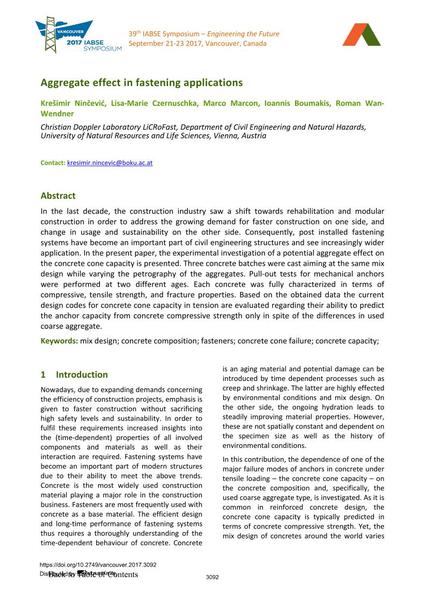Aggregate effect in fastening applications

|
|
|||||||||||
Bibliographic Details
| Author(s): |
Krešimir Ninčević
(Christian Doppler Laboratory LiCRoFast, Department of Civil Engineering and Natural Hazards, University of Natural Resources and Life Sciences, Vienna, Austria)
Lisa-Marie Czernuschka (Christian Doppler Laboratory LiCRoFast, Department of Civil Engineering and Natural Hazards, University of Natural Resources and Life Sciences, Vienna, Austria) Marco Marcon (Christian Doppler Laboratory LiCRoFast, Department of Civil Engineering and Natural Hazards, University of Natural Resources and Life Sciences, Vienna, Austria) Ioannis Boumakis (Christian Doppler Laboratory LiCRoFast, Department of Civil Engineering and Natural Hazards, University of Natural Resources and Life Sciences, Vienna, Austria) Roman Wendner (Christian Doppler Laboratory LiCRoFast, Department of Civil Engineering and Natural Hazards, University of Natural Resources and Life Sciences, Vienna, Austria) |
||||
|---|---|---|---|---|---|
| Medium: | conference paper | ||||
| Language(s): | English | ||||
| Conference: | IABSE Symposium: Engineering the Future, Vancouver, Canada, 21-23 September 2017 | ||||
| Published in: | IABSE Symposium Vancouver 2017 | ||||
|
|||||
| Page(s): | 3092-3098 | ||||
| Total no. of pages: | 7 | ||||
| Year: | 2017 | ||||
| DOI: | 10.2749/vancouver.2017.3092 | ||||
| Abstract: |
In the last decade, the construction industry saw a shift towards rehabilitation and modular construction in order to address the growing demand for faster construction on one side, and change in usage and sustainability on the other side. Consequently, post installed fastening systems have become an important part of civil engineering structures and see increasingly wider application. In the present paper, the experimental investigation of a potential aggregate effect on the concrete cone capacity is presented. Three concrete batches were cast aiming at the same mix design while varying the petrography of the aggregates. Pull-out tests for mechanical anchors were performed at two different ages. Each concrete was fully characterized in terms of compressive, tensile strength, and fracture properties. Based on the obtained data the current design codes for concrete cone capacity in tension are evaluated regarding their ability to predict the anchor capacity from concrete compressive strength only in spite of the differences in used coarse aggregate. |
||||
| Keywords: |
mix design concrete composition fasteners concrete cone failure concrete capacity
|
||||
